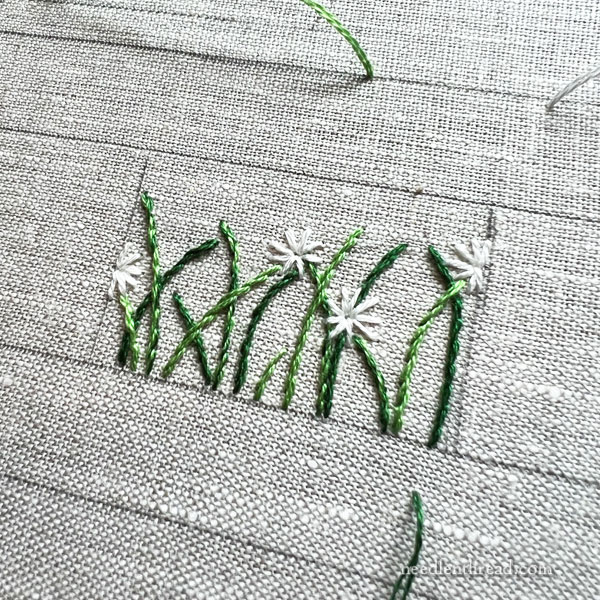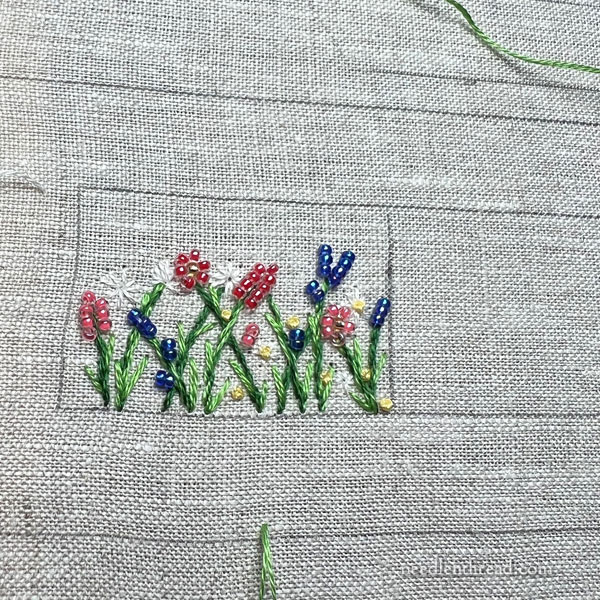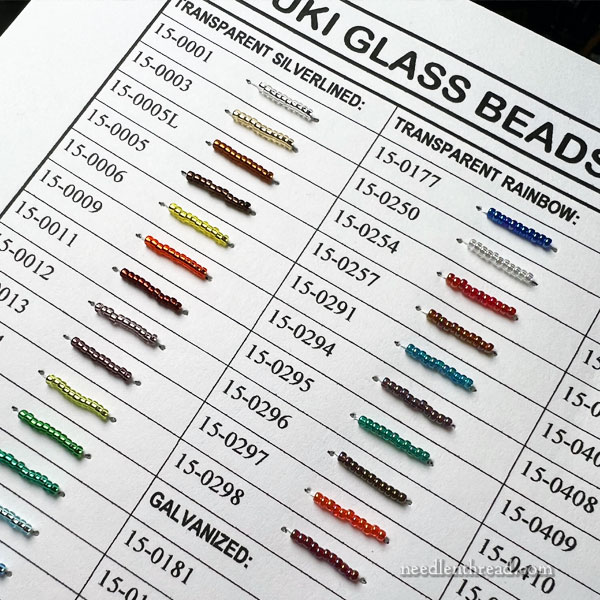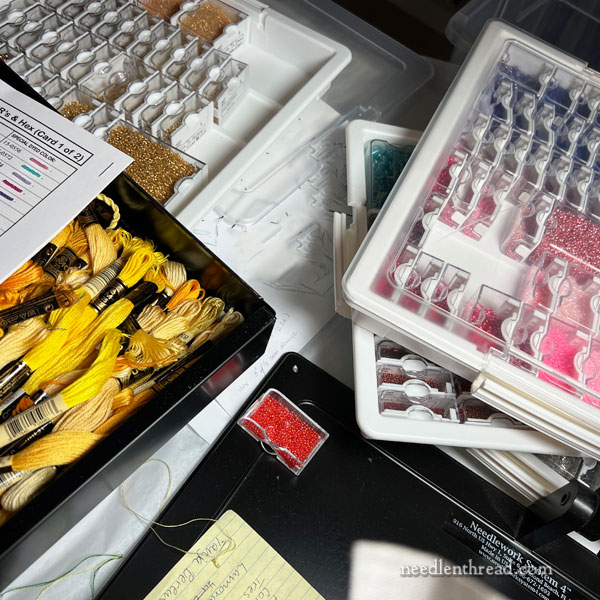Say you have a project in your head, and you know exactly what you want it to look like, and you know exactly what kind of threads and embellishments you want to incorporate on it, but you’re not exactly sure if it will all work the way you want it to.
Thread weight, bead size, embellishment size, stitch choice, colors, densities – all these things have to be taken into account when you’re planning a project, especially if you’re planning it to fit within certain parameters.

For example, I’ve got a small project in mind. It’s been floating around in my head for a while, and it’s working its way out now.
It’s small. Small-small. Not tiny-tiny. But not a Huge Project.
I know what I want it to look like.
And I know that I want to use beads on it.
I don’t know if I want to stitch with one strand of floss or two.
But I do know that I plan to incorporate some wool thread and some silk (not great quantities of each) along with standard cotton threads, some bead embellishment, perhaps a charm or two, and that there’s not a lot of space to do all that in.
I also know that the thing that I want to make has to be constructed.
This is what I’m doing this week: I’m not embroidering the entire thing. That would be a waste of time. Instead, I’m embroidering small parts that will give me the answers I’m looking for, and then I’m going to construct the thing in its experimental-and-partially-embroidered state, to make sure it comes together the way I have it in mind.

At this point, I’m not even working with the real design. I’m working with something akin to it, sketched free-hand onto my fabric.
I’m using the fabric I intend to use for the project – it’s Manuscript Vellum, a linen I’ve grown to love. I used it on this monogram, I used it on these strawberries here and these daisies here. I also used a very long scrap piece for this 2021 sampler project. It’s also in my natural linen fabric sampler pack (out of stock at the moment, sorry!).
But the fabric is just a scrap, really. It’s an off-cut piece that has some marks on it. Still, when I construct with it, I’ll learn what I need to learn about finishing The Thing that’s made out of this particular fabric.
Some of the questions I’m exploring:
Can I incorporate beads in a way that won’t look cluttered? Do even the 15/0 beads look too big in the space?
Should I stitch with one strand or two? If I stitch with one, will certain parts of the design (i.e., the white flowers) be visible enough? Should I use two strands for the white flowers and one strand for stems and leaves? Will one strand on stems and leaves give me the weight I need to support the use of beads? It might look rather stupid to have wimpy greenery supporting heavy beaded tops of the flowers. You’d wonder why they hadn’t drooped to the ground under all that top weight.
I’m not paying that much attention to the stitching itself. I will probably change the types of stitches eventually.

When I’m messing around with this kind of experimental process, it’s a great thing to have real bead color cards and real thread color cards to help choose colors and types of threads and beads.
I’ve written about real thread color cards here. Real bead color cards are the same concept. They’re available either from bead wholesalers or sometimes from bead manufacturers.
I’ve written about making my own real thread color cards for specific projects here.
I’ve also made my own thread cards for thread lines that don’t have real thread color cards available. You can see that going on in this article about Chameleon Threads.
As much as I’d love to have have on hand even a small quantity of all the threads or all the beads or all the fabrics I’d like to experiment with – so I can actually experiment! – it never works out that way.
It always seems that the fibers or beads or colors I want for this particular project or that particular project are never the ones that I have in my collections. So I have to do a little guesswork, and often, I have to order small quantities to experiment with. And then, of course, there’s the whole waiting forever for the package to arrive in the mail!
In the meantime, though, I can answer a lot of questions about the project by stitching with similar things.
I can use any 15/0 seed bead, to see if the size works.
I can use any color of stranded cotton, to test weights and stitch types.
I can use scrap linen to test constructional theories.
And I can do all of that before I order extras of anything. Testing this way helps me make more prudent decisions on what to order. It helps me prevent a lot of waste, too.

And while I do all this testing, I can make a jolly mess.
I’m very good at making jolly messes.
In fact, I think it’s what I do best.
So that’s how I spent my recent quality time with needle and thread. By the end of this week, my ideas will be solidified, I’ll know if I need to adjust my design or materials and so forth, and I’ll be ready to order exactly what I need to develop the project as planned. I’ll also be able to start a “real” version, photographing the whole project process from the start. And then – down the road! – Ill be able to share it all with you!
Something to look forward to!
Happy Monday! Here’s to a terrific week ahead!







I’m doing this with two projects at present! ACCCKKKKKK
Just my two cents worth…not crazy about the beads. Not enough to be major beadwork, too many to be an accent. Maybe denser greenery to support? Like a crazy riot of greenery under, around, and among the beads? But you know what they say about too many embroiderers! Good luck. Have fun!
Great summary of the “process” involved in working things out. I did not always do small samples before a larger project and I have regretted it. I especially liked the “any size 15” will work to try out the size. These days I am more apt to do smaller samples before embarking on a larger project. Thanks, as always for a good read.
Thank you for sharing your process. Designing all seems so mysterious and daunting. Your explanations make clear how much work and thought, trial and error goes into each piece. Appreciate you!
Thanks, Tina!
Jolly messes are exactly what this time of year is about lol.
Dear Mary
Wow such a lot of ideas floating around at onc time and all the decisions that need to be made before the final chosen materials can materialise and the project is underway. I love the way you take time and thought into constructing your ideas and putting them not on pen and paper but on real linen, thread, beads. I can’t wait to see the final decision on what you will choose for the project and to see the project itself. Thank for sharing with us your thoughts on how to construct and design a project from the beginning. I hope you get it going soon.
Regards Anita Simmance